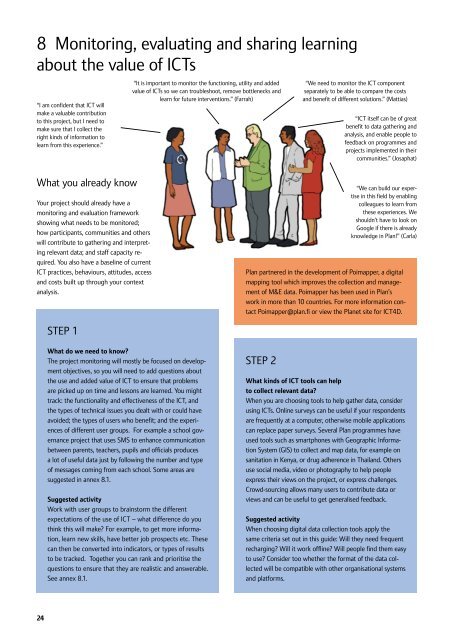nfplyk9
nfplyk9
nfplyk9
You also want an ePaper? Increase the reach of your titles
YUMPU automatically turns print PDFs into web optimized ePapers that Google loves.
8 Monitoring, evaluating and sharing learningabout the value of ICTs“I am confident that ICT willmake a valuable contributionto this project, but I need tomake sure that I collect theright kinds of information tolearn from this experience.”“It is important to monitor the functioning, utility and addedvalue of ICTs so we can troubleshoot, remove bottlenecks andlearn for future interventions.” (Farrah)“We need to monitor the ICT componentseparately to be able to compare the costsand benefit of different solutions.” (Mattias)“ICT itself can be of greatbenefit to data gathering andanalysis, and enable people tofeedback on programmes andprojects implemented in theircommunities.” (Josaphat)What you already knowYour project should already have amonitoring and evaluation frameworkshowing what needs to be monitored;how participants, communities and otherswill contribute to gathering and interpretingrelevant data; and staff capacity required.You also have a baseline of currentICT practices, behaviours, attitudes, accessand costs built up through your contextanalysis.“We can build our expertisein this field by enablingcolleagues to learn fromthese experiences. Weshouldn’t have to look onGoogle if there is alreadyknowledge in Plan!” (Carla)Plan partnered in the development of Poimapper, a digitalmapping tool which improves the collection and managementof M&E data. Poimapper has been used in Plan’swork in more than 10 countries. For more information contactPoimapper@plan.fi or view the Planet site for ICT4D.STEP 1What do we need to know?The project monitoring will mostly be focused on developmentobjectives, so you will need to add questions aboutthe use and added value of ICT to ensure that problemsare picked up on time and lessons are learned. You mighttrack: the functionality and effectiveness of the ICT, andthe types of technical issues you dealt with or could haveavoided; the types of users who benefit; and the experiencesof different user groups. For example a school governanceproject that uses SMS to enhance communicationbetween parents, teachers, pupils and officials producesa lot of useful data just by following the number and typeof messages coming from each school. Some areas aresuggested in annex 8.1.Suggested activityWork with user groups to brainstorm the differentexpectations of the use of ICT – what difference do youthink this will make? For example, to get more information,learn new skills, have better job prospects etc. Thesecan then be converted into indicators, or types of resultsto be tracked. Together you can rank and prioritise thequestions to ensure that they are realistic and answerable.See annex 8.1.STEP 2What kinds of ICT tools can helpto collect relevant data?When you are choosing tools to help gather data, considerusing ICTs. Online surveys can be useful if your respondentsare frequently at a computer, otherwise mobile applicationscan replace paper surveys. Several Plan programmes haveused tools such as smartphones with Geographic InformationSystem (GIS) to collect and map data, for example onsanitation in Kenya, or drug adherence in Thailand. Othersuse social media, video or photography to help peopleexpress their views on the project, or express challenges.Crowd-sourcing allows many users to contribute data orviews and can be useful to get generalised feedback.Suggested activityWhen choosing digital data collection tools apply thesame criteria set out in this guide: Will they need frequentrecharging? Will it work offline? Will people find them easyto use? Consider too whether the format of the data collectedwill be compatible with other organisational systemsand platforms.24


